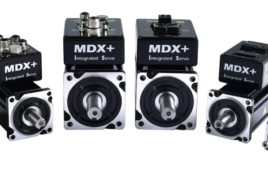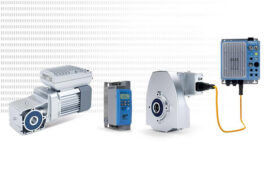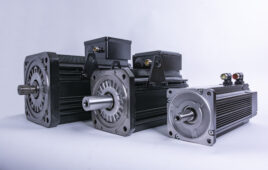
GMTO engineers
José Soto (left) and Hector Swett use TwinCAT 3 automation software from Beckhoff to validate various components according to the telescope specifications. (Giant Magellan Telescope —
GMTO Corporation)
EtherCAT and PC-based control have been specified for automation of the Giant Magellan Telescope, including more than 3,000 motion axes and site-wide fieldbus infrastructure.
Once installed at Las Campanas Observatory in the Chilean Andes, the Giant Magellan Telescope (GMT) will introduce many opportunities for the astrophysics and cosmology research communities. The telescope design will have an angular resolution ten times greater than that afforded by the Hubble Space Telescope by combining seven mirrors into a single optical system with a total diameter of 25 meters.
These advances will enable the GMT to capture images of astronomical objects sharper than currently possible by reducing distortions introduced by the terrestrial atmosphere. According to former GMTO Corporation Vice President Dr. Patrick McCarthy, “The GMT’s mission is to provide the tools that will enable future generations of astronomers to make great discoveries and push back the frontiers of our knowledge about the universe.”
Scientists and engineers working on similar telescope projects have traditionally built their own automation solutions using custom control components. However, the team building the GMT sees this differently, explains GMTO Senior Electronics Engineer José Soto: “We want to change the historical method of treating telescopes as special and totally unlike other automated systems. Future-facing industrial control solutions have the power to solve many problems we face today in astrophysics.”

Beckhoff AM8000 Servomotors are specified throughout the telescope design, which includes more than 3,000 axes of motion. (Giant Magellan Telescope – GMTO Corporation)
Specifying automation and controls components for the GMT required careful consideration due to the real-time communication and control requirements, especially considering the system will possess more than 3,000 axes of motion. Beyond rotating the telescope’s 22-story enclosure, the flexible mirrors must be moved with the utmost precision to implement adaptive optics and achieve the highest possible image resolution.
One example is the active optics system, which requires the integration of 170 pneumatic actuators per primary mirror to support the mass of each mirror. The engineering team identified the need for automation and controls components that were powerful now, but would also support future advances in technology, explains Soto: “Since these projects take a long time, we must account for obsolescence in every aspect. The most effective method of fighting obsolescence is standardizing on proven industrial technologies.” These factors led GMTO to standardize many specifications for the control system using industrial standards such as are found in solutions offered by Beckhoff Automation.
Looking to PC-based automation solutions
GMTO engineers began exploring industrial automation and controls. The engineers examined multiple industrial Ethernet networks but found EtherCAT to provide a flexible topology and scalability, along with the ability to incorporate up to 65,535 EtherCAT devices in one network, that matched the system specification of the GMT. “EtherCAT will be embedded in nearly every GMT telescope system — from the primary mirrors to the atmospheric dispersion compensator, the enclosure, mount, and even the building automation in the facilities,” Soto says.
According to GMTO Engineer Hector Swett, Safety over EtherCAT (FSoE) also offered impressive functionality for the telescope’s interlock and safety systems. FSoE provides GMT with safety-rated, TÜV-certified communication over standard EtherCAT networks, numerous options for distributed TwinSAFE I/O modules, and integration with the Beckhoff engineering environment and Industrial PCs (IPCs).
Certain current GMT specifications recommend multiple PC-based controllers that could be fulfilled by Beckhoff solutions. The interlock and safety system relies on many safety controllers and DIN-rail-mounted CX9020 Embedded PCs working in conjunction with EL6910 TwinSAFE Logic I/O modules. These interface with each other through FSoE via EtherCAT Automation Profile (EAP) to implement safety functions as required by the hazard analysis, Swett says. CX2020 Embedded PCs with single-core 1.4 GHz Intel Celeron processors are used in the GMT Hardware Development Kit, which was built for the project’s partners to develop instruments for the telescope.
TwinCAT 3 automation software has offered a key platform to test devices, and it is specified for control of the structures around the telescope. “The PC-based controller for the telescope’s enclosure will run TwinCAT directly,” Swett says. “It also provides the real-time capability to interface this massive application with the observatory control system via OPC UA.” Exemplifying system openness, TwinCAT supports programming of control logic in many languages, such as those included in IEC 61131-3, including object-oriented extensions, and the computer science languages offered in Microsoft Visual Studio. The software can automatically scan and configure third-party devices over ADS and EtherCAT, providing an optimal platform for tasks from sensing to motion control.

While working to implement off-the-shelf, industrial components into the telescope design, GMTO engineers have tested many Beckhoff components, including CX2020 Basic CPU Modules, AS1020 Stepper Motors, and EtherCAT I/O modules. (Giant Magellan Telescope – GMTO Corporation)
Because the telescope will have thousands of axes of motion, dependable motors and drives will be crucial in the final configuration. “When our integrator teams begin to commission the telescope, they will very likely use AM8000 Servomotors, for example, in the atmospheric dispersion compensator or the GIR (Gregorian Instrument Rotator) that will move all instruments attached to the Cassegrain focus,” Soto explains.
New technologies and creative ideas redefine our universe
After decades in the making, the end goal is coming into focus for GMTO, and the reliable automation and controls components specified for the telescope add clarity. Soto explains, “Using EtherCAT as the GMT fieldbus enables real-time communication down to the I/O-level. We have achieved cycle times of 2 kHz, which allows enough bandwidth to close the loop on a range of subsystems, expanding our control and networking abilities significantly.” Compact EtherCAT I/O modules and Embedded PCs save space in control cabinets, and because the PC-based controllers can be located at a distance from the I/Os, this reduces heat dissipation. “Reducing heat is a big deal for the GMT,” Swett adds. “Heat makes the air more turbulent inside the enclosure, and turbulence distorts images as the light travels through the air. This distributed I/O architecture helps us prevent that.”
In a decade, this process of observation and discovery will not belong to the engineers designing and building the GMT, but to the astrophysicists and cosmologists using it to explore the cosmos. Researchers will have the flexibility to bring their own creative ideas when using the telescope to make great discoveries that we have not yet even imagined.
Beckhoff Automation
beckhoffautomation.com
Filed Under: Motors • servo, Motors • stepper




